The Google Nexus 7 Review
by Anand Lal Shimpi & Brian Klug on July 26, 2012 11:35 AM ESTThe Display
In this new age of high resolution panels with small dimensions, the goal seems to be to just get the display out of the way. You shouldn't notice the display, it should just quietly do its job and make you believe that what you're looking at is real. When viewed with this critical eye, very few displays do their job well.
The Nexus 7's display is somewhere between good and perfection. It's not on the latter end of the spectrum, but it's great for $199. Black levels are good, and max brightness is more than enough for indoor use, although you'll have problems outdoors if it's too sunny.
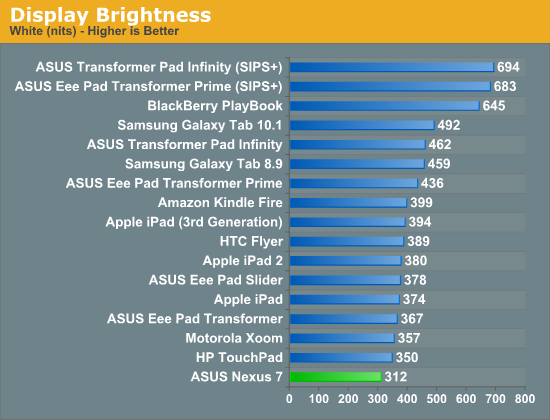
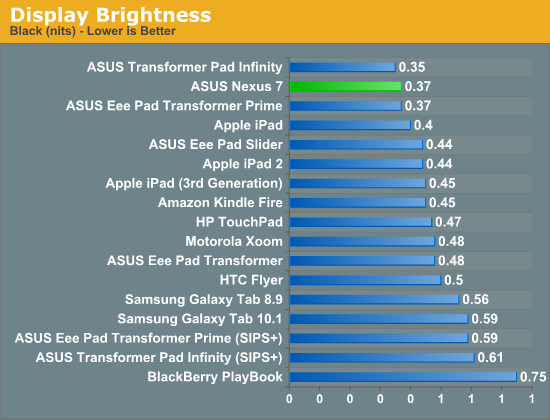

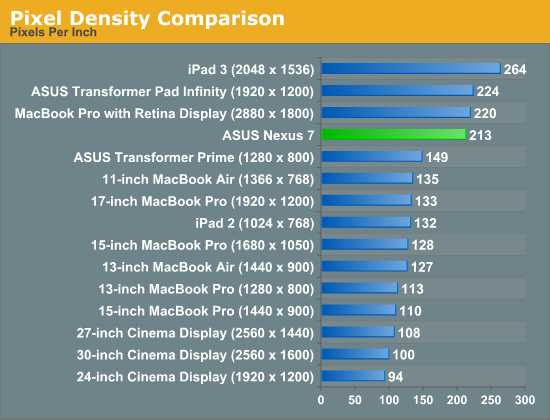
The resolution is high enough that neither Brian nor I were able to identify individual pixels at our normal viewing distances. Images do look better on the new iPad however (not a resolution but rather a panel advantage).
The other interesting aspect of the Nexus 7 is that it is a relatively new and somewhat interesting display form factor. 213 pixels per inch in a 7 inch display is unique for an Android tablet, and puts the Nexus 7 in the "tvdpi" screen density category for Android, 600 x 961 dp (that's dp - density independent pixels, relative to 160 ppi).
The end result is that some applications get a scaled down version of the 10" form factor Android 4.x UI, others don't. Some pages use the phone layout (for example the settings page, play store, and the notifications shade), others use the tablet two pane layout (for example Gmail) due to the 600dp width of the Nexus 7. That is to say it isn't totally correct to say that the UI on the Nexus 7 is a larger, scaled version of the phone UI, but something of an intermediary between the traditional 10" tablet version, and the phone version depending on what the break point is (in dps) for the particular app.
The other interesting note is that because 'tvdpi' isn't a primary display density for Android developers to build assets against, most often bitmaps get scaled down from the hdpi asset. In most places there isn't much of a noticeable softening of the edges, but I'll admit there are a few places where it's obvious bitmaps have been decimated and look a bit soft. Luckily, the pixel density of the display itself is high enough to mask most of this, but it isn't always perfect.
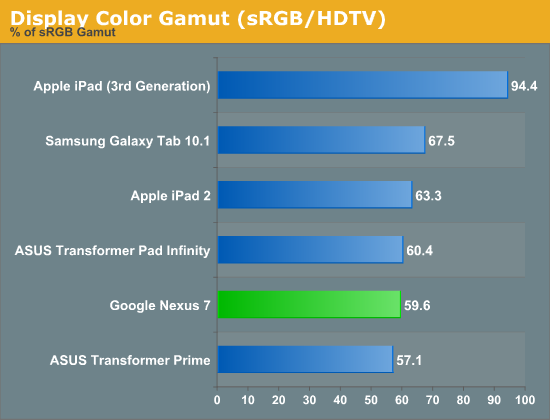
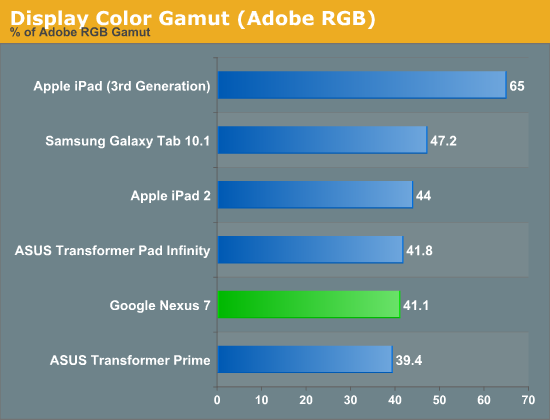
The Nexus 7's IPS panel offers great viewing angles, something that's simply a requirement for any device whose primary interface revolves around the display. Color accuracy is simply middle of the road, but I don't expect many users to do a lot of professional photo editing on the Nexus 7 so I'm not sure how much this actually matters.


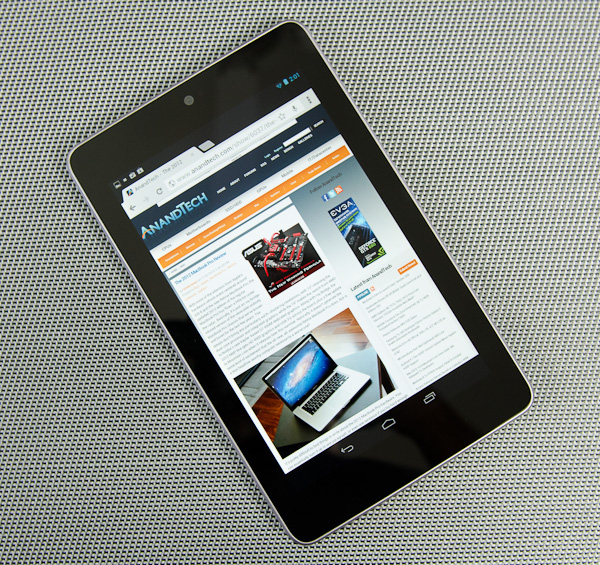








118 Comments
View All Comments
Death666Angel - Saturday, July 28, 2012 - link
My Chinese tablet and my SGS2 have Wifi set to always on and there is nearly no battery drainage. My SGS2 has standby time of over 5 days with Wifi on and occasional talks. My tablet has standby for over 2 days and I have never gotten it from 100% to <5% battery in a single day so far.Wifi is quite tame these days, I don't see any reason to not have it on all the time.
sjvarley - Friday, July 27, 2012 - link
"the limited NAND capacity prevents the Nexus 7 from being home to more than a single full length movie"Really?
If you need 8GB to store a full length movie on a tablet, then you're using the wrong codec.
tipoo - Friday, July 27, 2012 - link
Yeah, on a 7" screen a 700MB rip should look fine.ssddaydream - Friday, July 27, 2012 - link
I like to use uncompressed MKV.One of the things I would love if Anantech looked at was ability for the tablet to decode various vidoeos.
For example, I've had some trouble playing h264 1080p .MOV files smoothly (it was pretty bad, actually), but I haven't messed with it much yet. I'm confident that a good codec for 1080p content should scale the Nexus 7 display properly and still provide fluid playback.
Death666Angel - Saturday, July 28, 2012 - link
Since the SoC is strong enough to play back anything I throw at it from my normal TV media station, why I should I have to re-encode it for storage sake when storage is about the cheapest thing in the BOM of any tablet? Yes, I can do that, but I gain nothing from it except spend time when a few dollars worth of NAND could have gotten better results.And 700mb for 720p lasts you about 20 to 40 minutes, depending on how many audio streams you have and how much quality you want.
Torrijos - Friday, July 27, 2012 - link
Hi,nice review, as always, but a couple of reviews back you had a plot about device efficiency (a quotient of battery life and battery size).
It would be nice to have a repository article following the evolution of power efficiency with OS updates and the influence of the different CPU architectures.
tukkas - Friday, July 27, 2012 - link
how can the nexus 7 handle a shared device (i.e. multiple family members or guests) who don't want their gmail to necessarily be viewable by all? thank youHacp - Friday, July 27, 2012 - link
Why only bronze? I say if you are looking to buy a tablet without data, the Nexus 7 is at the best price point . Anandtech used to be about price/performance. I'm dissapointed.will2 - Friday, July 27, 2012 - link
An excellent review very thorough in important areas not covered by other reviewers, and with good insights comparing N7 with alternatives.However I think your verdict should list more negatives than limited unexpandable storage. To my mind another serious limitation of the hardware is lack of HDMI out.
I seek a small tablet (with enough memory to hold a reasonable selection of films) I can take around the home and plug into any TV to view, or likewise watch the films at a friends home. I want a tablet to be more multifunction, so when at the bedside it can be both both monitor CCTV and be used as an Alarm Clock Radio as it almost certainly has a FM radio in the same Broadcom chip for the WiFi & BT. Adding HDMI Out, be it via discrete HDMI socket, or cheap USB/MHL solution, and making available the embedded FM Radio, adds neglible cost to the product and makes it more widely useful.
TareX - Friday, August 3, 2012 - link
Then you don't want a $199 tablet.